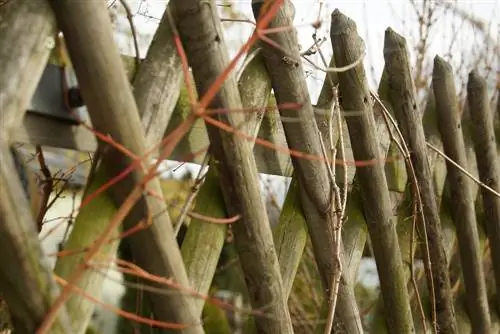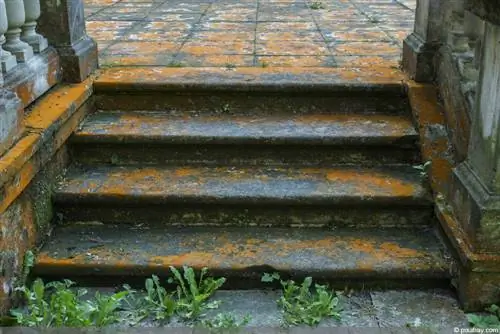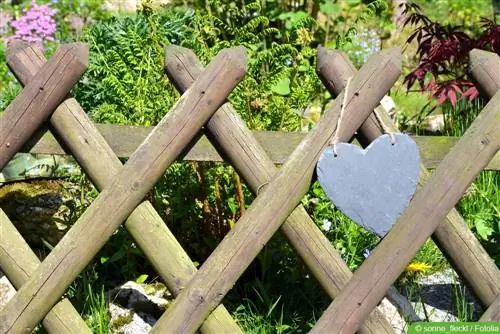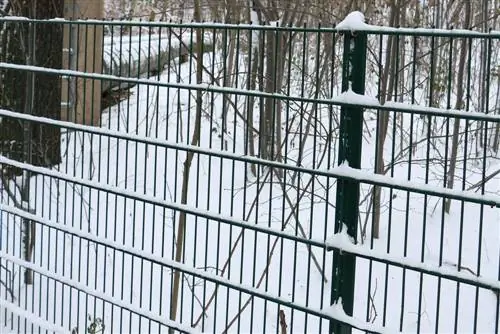- Author admin [email protected].
- Public 2023-12-17 03:39.
- Last modified 2025-06-01 06:48.
The hunter's fence actually has its origins in the hunting of wild animals. This type of fence had its origins in the wild breeding of red and fallow deer. Ever since all natural predators such as wolves and bears were driven out of the forests, game began to multiply significantly.
Friendly border development with traditional style - the hunter fence
The princes, who had the sole right to hunt these animals, took advantage of the large number of animals. This meant that they always had enough game in their forests that could be hunted. To prevent deer and wild boar from eating the fields adjacent to the forest, the fields and meadows were fenced off. However, a wild, undomesticated animal needs a much more stable fence than a peacefully grazing livestock. The demand for an inexpensive, easy-to-assemble and robust barrier ultimately led to the development of the hunter fence.
Components of a hunter's fence
The hunter's fence essentially consists of slats connected to each other in a cross shape. They are not mounted strictly horizontally and vertically, but rather in a diamond shape. Since the connecting nails are always located exactly in the middle of the cross points, the hunter's fence can do something very special: it can be folded up like a pair of scissors for transport. This reduces its length enormously and makes it particularly mobile.
Today the hunter's fence is made from round bars of spruce wood that are sawn lengthwise and sharpened. The prefabricated elements available on the market consistently impress with their highly precise manufacturing. A well-assembled hunter's fence conveys both tradition and order.
The hunter's fence is anchored in the ground with vertical posts. These posts can consist of simple piles driven into the ground. But a rotting process immediately begins there, which will destroy the hunter's fence within a few years.
However, a more durable solution is recommended for permanent fencing in the front garden: point foundations made of concrete provide the desired stability for decades.
Benefits of a hunter fence
The hunter fence is no longer used for its original purpose today. To protect fields from wild strikes, farmers today use inexpensive wire mesh or wire mesh fences. Building a hunter's fence out of natural wood is far too time-consuming these days. It also doesn't offer the protection that more modern versions can provide.
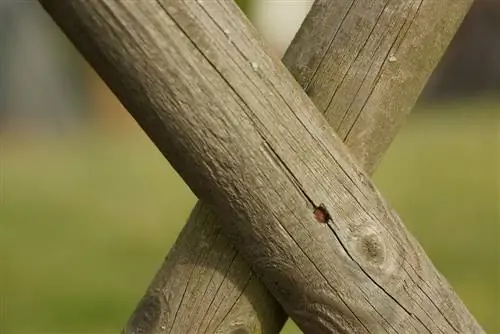
The hunter fence is now primarily used in the front garden. Here it primarily serves aesthetic and architectural purposes:
Demarcating a property is always a special challenge. On the one hand, you want to clearly mark the end of your property. On the other hand, you don’t want to “wall yourself in” with the demarcation and give your property a repellent appearance. Here the hunter fence is a very interesting, traditional and inexpensive solution.
The hunter fence offers:
- Stable border development
- Friendly, open appearance
- Inexpensive materials
- Easy assembly
- High tradition
- Robust and at the same time natural appearance
The hunter's fence is not an insurmountable obstacle. However, it is much more than a stretched string that marks the end of a property. You can't accidentally cross a hunter's fence. But whoever does it knows that they are on someone else's property.
Thanks to its wide, diamond-shaped mesh, the hunter's fence offers open views in and out of the property. In addition, the hunter's fence today is rarely higher than 60-80 cm. The barrier, which is only knee-high, further reinforces the friendly impression of the property. Hunter fences up to a height of 180 cm are commercially available. However, these variants are usually only used when they are used for animal husbandry.
A big advantage of the hunter fence is its price. The turned and sawn spruce poles usually come from fast-growing, young trees. The production processes are now highly optimized, so that the finished fence elements can be purchased at very reasonable prices. Typical hunter fence prices are:
- 250 cm element 60 cm high: approx. 25 euros
- 250 cm element, 80 cm high: approx. 33 euros
- 250 cm element, 100 cm high: approx. 38 euros
- 250 cm element, 120 cm high: approx. 42 euros
The retaining bars for vertical fastening are usually included in the sets available in stores. The gates are a little more expensive.
- Simple passage door for a 60 cm high hunter fence: approx. 45 euros
- Double gate with 300 cm width for vehicles: Approx. 100 - 150 euros
As mentioned at the beginning, a properly installed hunter's fence also requires a professionally placed point foundation. It is advisable to size it slightly larger. This gives you the freedom to build a larger or more stable fence later with the same effort.
For the point foundation of a fence, a diameter of 200 - 250 millimeters and a depth of 30-50 cm is sufficient.
A two meter long PVC pipe costs around 15 euros and is sufficient for at least four point foundations.
It holds almost 15 liters of concrete. That equates to about a bag and a half of ready-made concrete at 7.50 per bag.
Hunting as namesake
The traditional appearance of a hunter's fence generally makes it unproblematic under all local building regulations. You can't do anything wrong with a hunter's fence, but you can do a lot right. However, before building the border development, you should ask the responsible building authority which fences are permitted on site. This saves you a lot of money and hassle afterwards. In the case of false fences, the public order office usually dismantles the property at the owner's expense.
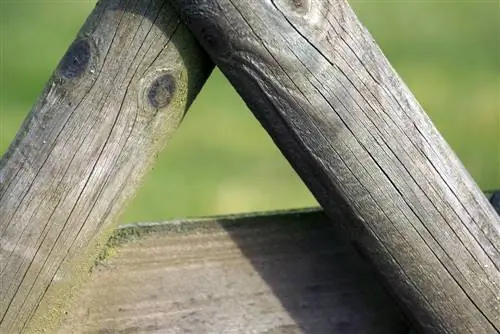
Finally, a hunter's fence is made of high-strength solid wood. It therefore definitely forms a barrier that can keep unwanted intruders away. It also takes a particularly strong storm for the hunter's fence to give way. This makes this type of fence very durable and long-lasting. With a little care, a hunter's fence can easily last 20 to 30 years.
Assembly of a hunter's fence
Even if the elements are very cheap, great care is recommended when building a hunter's fence. This is especially true if the fence is interrupted by a door or gate. A hunter's fence is delivered folded. Only at the construction site is it pulled apart and brought to the desired length and height. But if the fence is pulled apart to the right and left of the gate at different distances, you get a very unpleasant result. The effect of the hunter's fence comes from its geometric uniformity. If this is not taken into account, the fence will fail to be effective and the demarcation from the property will just look untidy.
The advantage of the hunter fence, however, is that it is quite insensitive to the support posts and point foundations. Unlike rigid, finished fence elements, the hunter fence is not installed between the posts, but in front of them. Nevertheless, the distance between the point foundations should be as uniform and regular as possible. A distance of 100, 200 or 250 cm is ideal. This means that the standard dimensions for fence elements are used right from the start. This means you can easily replace the hunter fence with another fence later.
If point foundations and vertical posts are installed, the fence is simply pulled apart and screwed in front of it. It is advisable to pre-drill the connection points between the fence and the post with a thin wood drill. Very thick, galvanized screws are required for fastening. A pre-drilled connection point reliably prevents cracking and splintering.
If the fence is interrupted by a gate, you should measure the height of a diamond from the first element with a ruler. This gives you the dimension to which you can pull the next fence element apart. This guarantees a decent result and avoids an unkempt impression from the outset. The hunter's fence can simply be sawed off at the overhang.
Maintaining the hunter's fence
The hunting fences available on the market today are generally vapor impregnated. This means they already offer a high level of weather protection ex works. Nevertheless, the hunter fence should be painted as soon as possible. However, there is a big mistake lurking here that greatly reduces the lifespan of a wooden fence: the use of closed-pored paint. Latex paint and similar types of paint that create an airtight surface are deadly to a hunter's fence. The wood can no longer “breathe” and the trapped moisture causes the fence to rot from the inside out.
The right weather
Painting a hunter's fence is best done in cool weather and cloudy skies. A burning sun would cause the paint to dry too quickly. In addition, working above 28° is uncomfortable. If there is no other option, don't forget to drink plenty of fluids and wear head protection. This effectively prevents sunstroke.
The right color
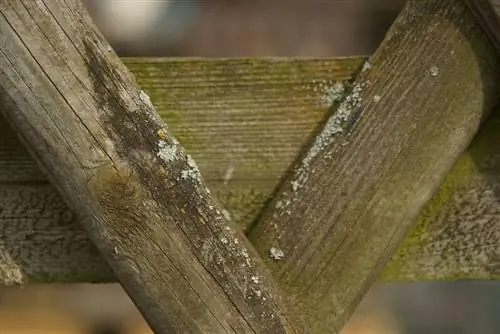
Only “exterior wood protection paint” is permitted for a hunter’s fence. It is open-pored and allows gas exchange from the wood. At the same time, the paint repels mold, lichen and bacteria so that the fence lasts for a long time. Wood protection paint is now available in many different colors. The traditional dark brown can now be varied with a lighter red or even a bright white. Wood protection paints usually consist of several components. These components separate from each other during storage. The paint must therefore always be stirred well before painting. All you need is a crooked nail on a cordless screwdriver. A can with five liters of wood protection paint costs around 25 euros. It is enough for 50 square meters. This is absolutely sufficient for a normal hunter's fence. Unfortunately it is not very durable. Leftover paint can be sold or must be disposed of properly.
Occupational safety comes first
Wood protection paint is not only terribly sticky and almost impossible to get out of clothes. It's not exactly good for your he alth either. Wood protection paint contains some toxins that are supposed to have a selective effect against the infestation of mold and rot. Direct contact with the body should therefore be avoided. When painting, it is best to use old clothes that you can throw away after work. Protect your hands with gloves.
Respiratory protection is usually no longer necessary with modern colors. If in doubt, a look at the manufacturer's information provides the necessary security. The lawn below the fence should also be protected against paint drips. A piece of cardboard is sufficient here, which is placed along the fence. It stays there until the paint is completely dry. A small stool is recommended so that the cross does not become lame when painting. This means you can work while sitting and your back stays straight.
Patience when painting
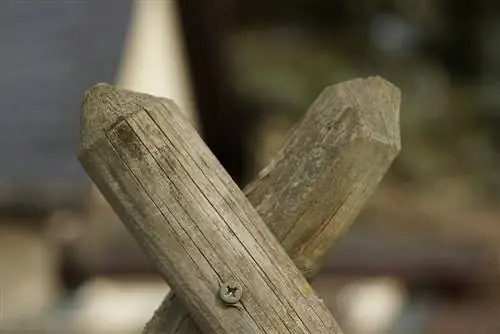
Painting a hunter's fence is technically not very difficult. Nevertheless, it should be done with the necessary patience and care. The paint must be applied thickly to the wood so that it can be deeply absorbed. The deeper the protective color can penetrate, the longer the wood will resist the destructive forces. Spraying using paint guns with a compressor is therefore unsuitable. Although these deliver a good result, they tend to miss the mark in light winds. Then you have the paint on the sidewalk, on the house wall or your car. When painting a hunter's fence, only a brush and a lot of patience guarantee safety and a correct result.
As with any painting process, the fence elements are painted batten by batten from top to bottom. This is how runners are caught and distributed. But don't worry: in no time you'll get the hang of how to get a beautifully painted fence with a brush and paint.
Conclusion
- Easily assembled, inexpensive and aesthetic border development -
A hunter's fence conveys a sense of tradition. Done correctly and neatly, it becomes the homeowner's calling card. A proper hunter's fence keeps visitors on the outside until you invite them. However, it invites you to look beyond and does not differentiate psychologically. This traditional and at the same time friendly appearance makes the hunter fence still one of the most popular border developments there is.

